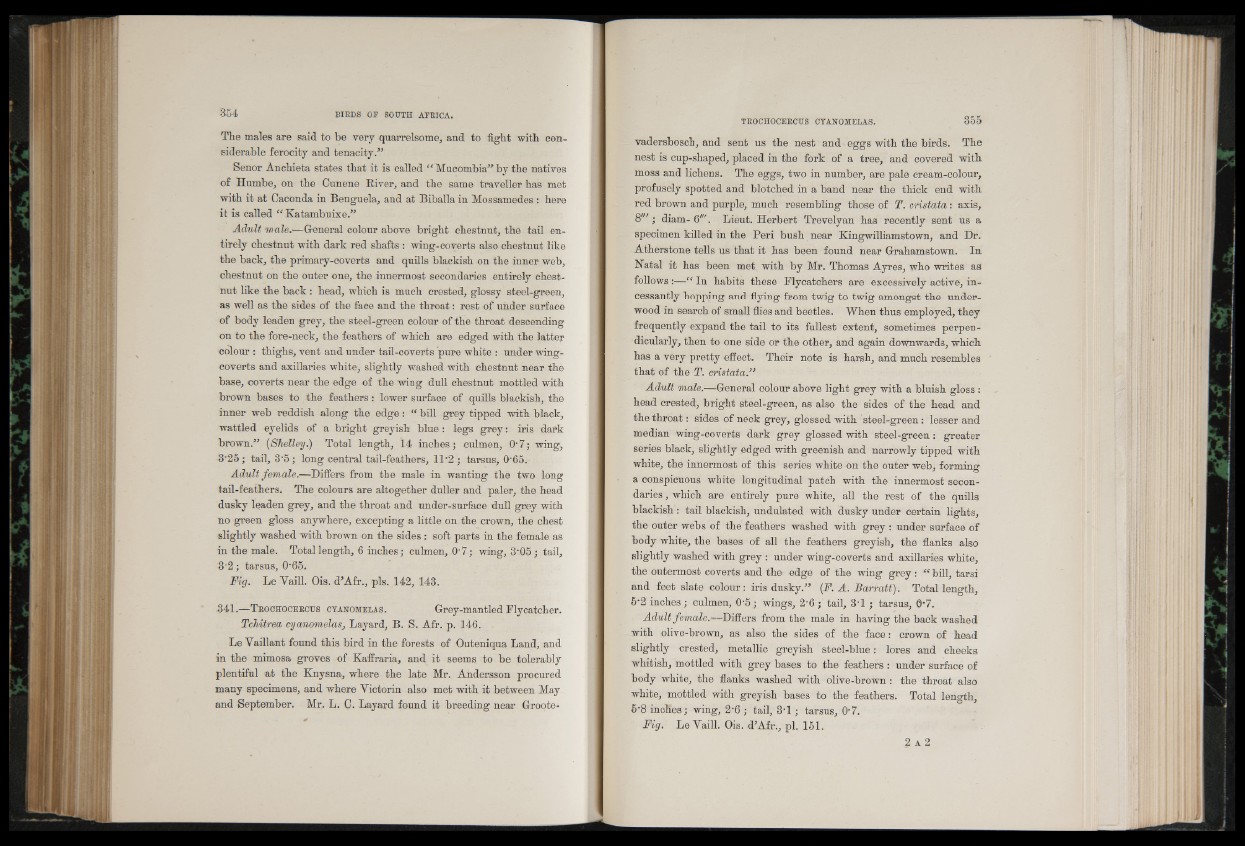
The males are said to be very quarrelsome, and to fight with considerable
ferocity and tenacity.”
Senor Anchieta states that it is called “ Mucombia” by the natives
of Humbe, on the Cunene River, and the same traveller has met
with it at Caconda in Benguela, and at Biballa in Mossamedes : here
it is called “ Katambuixe.”
Adult male.—General colour above bright chestnut, the tail entirely
chestnut with dark red shafts : wing-coyerts also chestnut like
the back, the primary-coverts and quills blackish on the inner web,
chestnut on the outer one, the innermost secondaries entirely chestnut
like the back : head, which is much crested, glossy steel-green,
as well as the sides of the face and the throat: rest of under surface
of body leaden grey, the steel-green colour of the throat descending
on to the fore-neck, the feathers of which are edged with the latter
colour : thighs, vent and under tail-coverts pure white : under wing-
coverts and axillaries white, slightly washed with chestnut near the
base, coverts near the edge of the wing dull chestnut mottled with
brown bases to the feathers: lower surface of quills blackish, the
inner web reddish along the edge: “ bill grey tipped with black,
wattled eyelids of a bright greyish blue : legs grey: iris dark
brown.” [Shelley.) Total length, 14 inches; culmen, O'7; wing,
3'25; tail, 3'5; long central tail-feathers, 11 '2 ; tarsus, 0'65.
Adult female.—Differs from the male in wanting the two long
tail-feathers. The colours are altogether duller and paler, the head
dusky leaden grey, and the throat and under-surface dull grey with
no green gloss anywhere, excepting a little on the crown, the chest
slightly washed with brown on the sides : soft parts in the female as
in the male. Total length, 6 inches ; culmen, O'7; wing, 3'05; tail,
3'2; tarsus, 0'65.
Fig. Le Vaill. Ois. d’Afr., pis. 142, 143.
341.—T rochoceecus cyanomelas. Grey-mantled Flycatcher.
Tchitrea cyanomelas, Layard, B. S. Afr. p. 146.
Le Vaillant found this bird in the forests of Outeniqua Land, and
in the mimosa groves of Kaffraria, and it seems to be tolerably
plentiful at the Knysna, where the late Mr. Andersson procured
many specimens, and where Victorin also met with it between May
and September. Mr. L. C. Layard found it breeding near Grootevadersbosch,
and sent us the nest and'eggs with the birds. The
nest is cup-shaped, placed in the fork of a tree, and covered with
moss and lichens. The eggs, two in number, are pale cream-colour,
profusely spotted and blotched in a band near the thick end with
red brown and purple, much resembling those of T. cristata: axis,
8'" ; diam- 6'". Lieut. Herbert Trevelyan has recently sent us a
specimen killed in the Peri bush near Kingwilliamstown, and Dr.
Atherstone tells us that it has been found near Grahamstown. In
Natal it has been met with by Mr. Thomas Ayres, who ■writes as
follows:—“ In habits these Flycatchers are excessively active, incessantly
hopping and flying from twig to twig amongst the underwood
in search of small flies and beetles. When thus employed, they
frequently expand the tail to its fullest extent, sometimes perpendicularly,
then to one side or the other, and again downwards, which
has a very pretty effect. Their note is harsh, and much resembles
that of the T. cristata.”
Adult male.—General colour above light grey with a bluish gloss :
head crested, bright steel-green, as also the sides of the head and
the throat: sides of neck grey, glossed with steel-green: lesser and
median wing-eoverts dark grey glossed with steel-green : greater
series black, slightly edged with greenish and narrowly tipped with
white, the innermost of this series white on the outer web, forming
a conspicuous white longitudinal patch with the innermost secondaries
, which are entirely pure white, all the rest of the quills
blackish : tail blackish, undulated with dusky under certain lights,
the outer webs of the feathers washed with grey : under surface of
body white, the bases of all the feathers greyish, the flanks also
slightly washed with grey : under wing-coverts and axillaries white,
the outermost coverts and the edge of the wing grey : “ bill, tarsi
and feet slate colour: iris dusky.” [F. A. Barratt). Total length,
5'2 inches ; culmen, 0'5 ; wings, 2'6 ; tail, 3'1 ; tarsus, 0'7.
Adult female.—Differs from the male in having the back washed
with olive-brown, as also the sides of the face: crown of head
slightly crested, metallic greyish steel-blue: lores and cheeks
whitish, mottled with grey bases to the feathers : under surface of
body white, the flanks washed with olive-brown : the throat also
white, mottled with greyish bases to the feathers. Total length,
5'8 inches; wing, 2'6 ; tail, 3 '1 ; tarsus, 07.
Fig. Le Vaill. Ois. d’Afr., pi. 151.
2 a 2